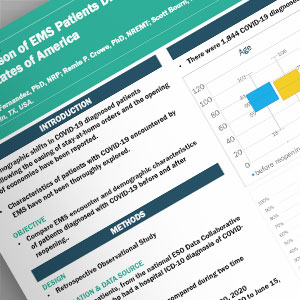ABSTRACTS
A Comparison of EMS Patients Diagnosed with COVID-19 Before and After Reopening in the United States of AmericaAuthor: Antonio Fernandez PhD, NRP | Research Scientist | ESO Associate Authors: Crowe, Remle, P, PhD, NREMT | Bourn, Scott, PhD, RN | Myers, J. Brent, MD, MPH, FACEP
Introduction: Demographic shifts in COVID-19 diagnosed patients following the easing of stay-at-home orders and the opening of economies have been reported. Characteristics of patients with COVID-19 encountered by EMS have not been thoroughly explored. Objective: Compare EMS encounter and demographic characteristics of patients diagnosed with COVID-19 before and after reopening. Methods: This retrospective analysis evaluated prehospital records for all 9-1-1 patients, from the national ESO Data Collaborative (Austin, TX), who had a hospital ICD-10 diagnosis of COVID-19. Patient demographics were compared during two time periods. For the analysis, March 15, 2020 to April 30, 2020 represented before reopening while May 1, 2020 to June 15, 2020 was considered after reopening. Patient demographics including age, race, and sex were examined. Age was examined as both a continuous variable and dichotomized (<40/≥40). Incident location type was also examined. Chi-Square and Wilcoxon Rank Sum Tests were performed. Results: There were 1,844 COVID-19 diagnosed 9-1-1 patients before reopening and 1,765 after reopening. The median age before reopening (69; interquartile range [IQR] 55-81) was significantly (p<0.01) higher than after reopening (64.5; IRQ: 50—78). More patients were <40 after reopening (18% 326 vs. 24%, 421, p<0.001). The percentage of patients recorded as black (29%, 439 vs. 28%, 426) or white (53%, 806 vs. 46%, 706) was lower after reopening while those recorded as Hispanic/Latino (16%, 244 vs. 22% 339) or other (3%, 43 vs. 4%, 60) were higher after reopening (p<0.001). There was no significant difference noted in patient sex (p=0.73). Slightly more patients were transported from healthcare facilities (5%, 78 vs. 7%, 100) or home/residence (53%, 814 vs. 55%, 839) after reopening while slightly less were transported from nursing homes/assisted living facilities (33%, 515 vs. 32%, 479), police/jail (2%, 24 vs. 1%, 15), or other (2%, 30 vs. 1%, 15), and patient transports were similar from public places (5%, 81 vs. 5%, 74) (p=0.04). Conclusion: EMS patients diagnosed with COVID-19 were younger after the easing of stay-at-home orders. There were more patients reported to be Hispanic/Latino or other race and slightly more patients transported from home/residence and healthcare facilities
|

